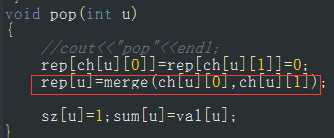题目描述
如题,一开始有N个小根堆,每个堆包含且仅包含一个数。接下来需要支持两种操作:
操作1: 1 x y 将第x个数和第y个数所在的小根堆合并(若第x或第y个数已经被删除或第x和第y个数在用一个堆内,则无视此操作)
操作2: 2 x 输出第x个数所在的堆最小数,并将其删除(若第x个数已经被删除,则输出-1并无视删除操作)
输入输出格式
输入格式:
第一行包含两个正整数N、M,分别表示一开始小根堆的个数和接下来操作的个数。
第二行包含N个正整数,其中第i个正整数表示第i个小根堆初始时包含且仅包含的数。
接下来M行每行2个或3个正整数,表示一条操作,格式如下:
操作1 : 1 x y
操作2 : 2 x
输出格式:
输出包含若干行整数,分别依次对应每一个操作2所得的结果。
输入输出样例
5 5 1 5 4 2 3 1 1 5 1 2 5 2 2 1 4 2 2 2
1 2
说明
当堆里有多个最小值时,优先删除原序列的靠前的,否则会影响后续操作1导致WA。
时空限制:1000ms,128M
数据规模:
对于30%的数据:N<=10,M<=10
对于70%的数据:N<=1000,M<=1000
对于100%的数据:N<=100000,M<=100000
样例说明:
初始状态下,五个小根堆分别为:{1}、{5}、{4}、{2}、{3}。
第一次操作,将第1个数所在的小根堆与第5个数所在的小根堆合并,故变为四个小根堆:{1,3}、{5}、{4}、{2}。
第二次操作,将第2个数所在的小根堆与第5个数所在的小根堆合并,故变为三个小根堆:{1,3,5}、{4}、{2}。
第三次操作,将第2个数所在的小根堆的最小值输出并删除,故输出1,第一个数被删除,三个小根堆为:{3,5}、{4}、{2}。
第四次操作,将第4个数所在的小根堆与第2个数所在的小根堆合并,故变为两个小根堆:{2,3,5}、{4}。
第五次操作,将第2个数所在的小根堆的最小值输出并删除,故输出2,第四个数被删除,两个小根堆为:{3,5}、{4}。
故输出依次为1、2。
模板题,不解释
#include<iostream> #include<cstdio> #include<algorithm> #define maxn 100005 using namespace std; int val[maxn],dis[maxn],ch[maxn][2],rep[maxn]; int n,m; int merge(int A,int B) { if(!A) return B; if(!B) return A; if(val[A]>val[B]||val[A]==val[B]&&A>B) swap(A,B); ch[A][1]=merge(ch[A][1],B); rep[ch[A][1]]=A; if(dis[ch[A][0]]<dis[ch[A][1]]) swap(ch[A][0],ch[A][1]); dis[A]=dis[ch[A][1]]+1; return A; } int getrep(int x) { while(rep[x])x=rep[x]; return x; } int main() { scanf("%d %d",&n,&m);dis[0]=-1; for(int i=1;i<=n;i++) scanf("%d",&val[i]); while(m--) { int Mode,x,y; scanf("%d",&Mode); if(Mode==1) { scanf("%d %d",&x,&y); if(val[x]==-1||val[y]==-1) continue; x=getrep(x),y=getrep(y); if(x!=y) { merge(x,y); } }else { scanf("%d",&x); if(val[x]==-1) { puts("-1"); }else { x=getrep(x); printf("%d\n",val[x]); val[x]=-1; rep[ch[x][0]]=rep[ch[x][1]]=0; merge(ch[x][0],ch[x][1]); } } } }
第二题
Input
Output
Sample Input
5 4
0 3 3
1 3 5
2 2 2
1 2 4
2 3 1
#include <vector> #include <cstdlib> #include<cstdio> #include <algorithm> using namespace std; typedef long long ll; vector<ll> vec[100010]; struct Node { ll val, fa, left, right; } tree[100010]; ll dist[100010]; ll n, m, sj[100010], c[100010], l[100010], cases, x, y, sum[100010], num[100010], _root, root[100010], ans; ll merge(ll A, ll B) { if (!A || !B) return A + B; if ((tree[A].val < tree[B].val) || (tree[A].val == tree[B].val && A > B)) swap(A, B); ll tmp; tree[A].right = tmp = merge(tree[A].right, B); tree[tmp].fa = A; if (dist[tree[A].right] > dist[tree[A].left]) swap(tree[A].right, tree[A].left); dist[A] = dist[tree[A].right] + 1; return A; } ll get_father(ll A) { return tree[A].fa ? get_father(tree[A].fa) : A; } ll erase(ll B) { ll A = root[B]; //printf("erase%lld\n", tree[A].val); sum[B] -= tree[A].val; num[B]--; tree[tree[A].left].fa = 0; tree[tree[A].right].fa = 0; tree[A].val = 0; return merge(tree[A].left, tree[A].right); } void addedge(ll u, ll v) { vec[u].push_back(v); } void dfs(ll x) { //printf("in%lld\n", x); for (ll i = 0; i < vec[x].size(); i++) { dfs(vec[x][i]); root[x] = merge(root[x], root[vec[x][i]]); sum[x] += sum[vec[x][i]]; num[x] += num[vec[x][i]]; while (sum[x] > m) root[x] = erase(x); } sum[x] += c[x]; num[x]++; tree[x] = (Node){c[x], x, 0, 0}; root[x] = merge(root[x], x); while (sum[x] > m) root[x] = erase(x); ans = max(ans, num[x] * l[x]); //printf("out%lld\n", x); } int main() { scanf("%lld%lld", &n, &m); for (ll i = 1; i <= n; i++) { scanf("%lld%lld%lld", &sj[i], &c[i], &l[i]); if (sj[i] == 0) _root = i; else addedge(sj[i], i); } dfs(1); printf("%lld\n", ans); //system("pause"); return 0; }
不过何dalao写了1个右偏树,合并还是左偏树的方法,%%%
我就加了蜜汁一句话,就A了
#include<iostream> #include<cstdio> #include<algorithm> #define maxn 100005 using namespace std; int to[maxn],next[maxn],head[maxn]; int rep[maxn],val[maxn],ch[maxn][2],dis[maxn]; int sz[maxn],leader[maxn]; long long sum[maxn]; int n,m,num; long long ans; void make_way(int u,int v) { to[++num]=v; next[num]=head[u]; head[u]=num; } void update(int u) { sz[u]=sz[ch[u][0]]+sz[ch[u][1]]+1; sum[u]=sum[ch[u][0]]+sum[ch[u][1]]+val[u]; } int merge(int A,int B) { //cout<<"merge"<<endl; if(!A) return B; if(!B) return A; if(val[A]<val[B]) swap(A,B); ch[A][1]=merge(ch[A][1],B); rep[ch[A][1]]=A; if(dis[ch[A][0]]<dis[ch[A][1]]) swap(ch[A][0],ch[A][1]); dis[A]=dis[ch[A][1]]+1; update(A); return A; } void pop(int u) { //cout<<"pop"<<endl; rep[ch[u][0]]=rep[ch[u][1]]=0; rep[u]=merge(ch[u][0],ch[u][1]); sz[u]=1;sum[u]=val[u]; } int getrep(int u) { //cout<<"getrep"<<endl; while(rep[u]) { u=rep[u]; } return u; } void dfs(int u) { for(int edge=head[u];edge;edge=next[edge]) { int v=to[edge]; dfs(v); merge(getrep(u),getrep(v)); } while(sum[getrep(u)]>m&&sz[getrep(u)]) { //cout<<val[getrep(u)]<<endl; pop(getrep(u)); } ans=max(ans,(long long)sz[getrep(u)]*leader[u]); //cout<<u<<‘ ‘<<ans<<endl; } int main() { scanf("%d %d",&n,&m); dis[0]=-1; for(int i=1;i<=n;i++) { int pp; scanf("%d %d %d",&pp,&val[i],&leader[i]); make_way(pp,i); sum[i]=val[i];sz[i]=1; } dfs(1); cout<<ans<<endl; }
 不要问我为什么
不要问我为什么
